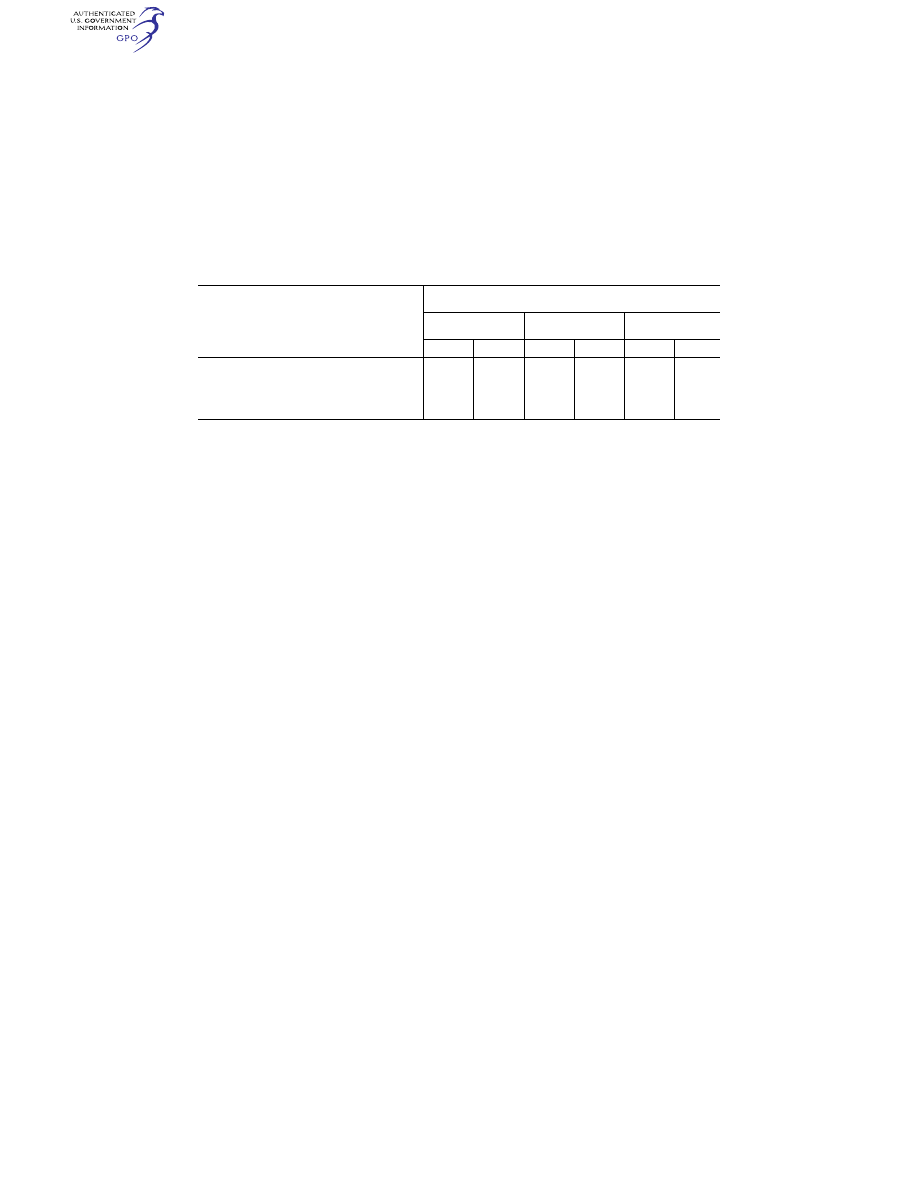
28
14 CFR Ch. I (1–1–24 Edition)
Pt. 117, Table C
T
ABLE
C
TO
P
ART
117—F
LIGHT
D
UTY
P
ERIOD
: A
UGMENTED
O
PERATIONS
Scheduled time of start (acclimated time)
Maximum flight duty period (hours) based on rest facility and
number of pilots
Class 1
rest facility
Class 2
rest facility
Class 3
rest facility
3 pilots
4 pilots
3 pilots
4 pilots
3 pilots
4 pilots
0000–0559 ....................................................................
15
17
14
15.5
13
13.5
0600–0659 ....................................................................
16
18.5
15
16.5
14
14.5
0700–1259 ....................................................................
17
19
16.5
18
15
15.5
1300–1659 ....................................................................
16
18.5
15
16.5
14
14.5
1700–2359 ....................................................................
15
17
14
15.5
13
13.5
PART 118
[
RESERVED
]
PART 119—CERTIFICATION: AIR
CARRIERS AND COMMERCIAL
OPERATORS
Subpart A—General
Sec.
119.1
Applicability.
119.3
[Reserved]
119.5
Certifications, authorizations, and
prohibitions.
119.7
Operations specifications.
119.8
Safety Management Systems.
119.9
Use of business names.
Subpart B—Applicability of Operating Re-
quirements to Different Kinds of Oper-
ations Under Parts 121, 125, and 135 of
This Chapter
119.21
Commercial operators engaged in
intrastate common carriage and direct
air carriers.
119.23
Operators engaged in passenger-car-
rying operations, cargo operations, or
both with airplanes or powered-lift when
common carriage is not involved.
119.25
Rotorcraft operations: Direct air car-
riers and commercial operators.
Subpart C—Certification, Operations Spec-
ifications, and Certain Other Require-
ments for Operations Conducted
Under Part 121 or Part 135 of This
Chapter
119.31
Applicability.
119.33
General requirements.
119.35
Certificate application requirements
for all operators.
119.36
Additional certificate application re-
quirements for commercial operators.
119.37
Contents of an Air Carrier Certificate
or Operating Certificate.
119.39
Issuing or denying a certificate.
119.41
Amending a certificate.
119.43
Certificate holder’s duty to maintain
operations specifications.
119.45
[Reserved]
119.47
Maintaining a principal base of oper-
ations, main operations base, and main
maintenance base; change of address.
119.49
Contents of operations specifications.
119.51
Amending operations specifications.
119.53
Wet leasing of aircraft and other ar-
rangements for transportation by air.
119.55
Obtaining deviation authority to per-
form operations under a U.S. military
contract.
119.57
Obtaining deviation authority to per-
form an emergency operation.
119.59
Conducting tests and inspections.
119.61
Duration and surrender of certificate
and operations specifications.
119.63
Recency of operation.
119.65
Management personnel required for
operations conducted under part 121 of
this chapter.
119.67
Management personnel: Qualifica-
tions for operations conducted under
part 121 of this chapter.
119.69
Management personnel required for
operations conducted under part 135 of
this chapter.
119.71
Management personnel: Qualifica-
tions for operations conducted under
part 135 of this chapter.
119.73
Employment of former FAA employ-
ees.
A
UTHORITY
: 49 U.S.C. 106(f), 106(g), 40101,
40102, 40103, 40113, 44105, 44106, 44111, 44701–
44717, 44722, 44901, 44903, 44904, 44906, 44912,
44914, 44936, 44938, 46103, 46105; sec. 215, Pub.
L. 111–216, 124 Stat. 2348.
S
OURCE
: Docket No. 28154, 60 FR 65913, Dec.
20, 1995, unless otherwise noted.
Subpart A—General
§ 119.1 Applicability.
(a) This part applies to each person
operating or intending to operate civil
aircraft—
(1) As an air carrier or commercial
operator, or both, in air commerce; or
(2) When common carriage is not in-
volved, in operations of any U.S.-reg-
istered civil airplane or powered-lift

29
Federal Aviation Administration, DOT
§ 119.1
with a seat configuration of 20 or more
passengers, or a maximum payload ca-
pacity of 6,000 pounds or more; or
(3) When noncommon carriage is in-
volved, except as provided in § 91.501(b)
of this chapter, or in private carriage
for compensation or hire, in operations
of any U.S.-registered civil airplane or
powered-lift with a passenger-seat con-
figuration of less than 20 seats and a
payload capacity of less than 6,000
pounds.
(b) This part prescribes—
(1) The types of air operator certifi-
cates issued by the Federal Aviation
Administration, including air carrier
certificates and operating certificates;
(2) The certification requirements an
operator must meet in order to obtain
and hold a certificate authorizing oper-
ations under part 121, 125, or 135 of this
chapter and operations specifications
for each kind of operation to be con-
ducted and each class and size of air-
craft to be operated under part 121 or
135 of this chapter;
(3) The requirements an operator
must meet to conduct operations under
part 121, 125, or 135 of this chapter and
in operating each class and size of air-
craft authorized in its operations speci-
fications;
(4) Requirements affecting wet leas-
ing of aircraft and other arrangements
for transportation by air;
(5) Requirements for obtaining devi-
ation authority to perform operations
under a military contract and obtain-
ing deviation authority to perform an
emergency operation; and
(6) Requirements for management
personnel for operations conducted
under part 121 or part 135 of this chap-
ter.
(c) Persons subject to this part must
comply with the other requirements of
this chapter, except where those re-
quirements are modified by or where
additional requirements are imposed
by part 119, 121, 125, or 135 of this chap-
ter.
(d) This part does not govern oper-
ations conducted under part 91, subpart
K (when common carriage is not in-
volved) nor does it govern operations
conducted under part 129, 133, 137, or
139 of this chapter.
(e) Except for operations when com-
mon carriage is not involved conducted
with any airplane or powered-lift hav-
ing a passenger-seat configuration of 20
seats or more, excluding any required
crewmember seat, or a payload capac-
ity of 6,000 pounds or more, this part
does not apply to—
(1) Student instruction;
(2) Nonstop Commercial Air Tours
that occur in an airplane, powered-lift,
or rotorcraft having a standard air-
worthiness certificate and passenger-
seat configuration of 30 seats or fewer
and a maximum payload capacity of
7,500 pounds or less that begin and end
at the same airport, and are conducted
within a 25-statute mile radius of that
airport, in compliance with the Letter
of Authorization issued under § 91.147 of
this chapter. For nonstop Commercial
Air Tours conducted in accordance
with part 136, subpart B, of this chap-
ter, National Parks Air Tour Manage-
ment, the requirements of this part
apply unless excepted in § 136.37(g)(2).
For Nonstop Commercial Air Tours
conducted in the vicinity of the Grand
Canyon National Park, Arizona, the re-
quirements of SFAR 50–2, part 93, sub-
part U, of the chapter and this part, as
applicable, apply.
(3) Ferry or training flights;
(4) Aerial work operations, includ-
ing—
(i) Crop dusting, seeding, spraying,
and bird chasing;
(ii) Banner towing;
(iii) Aerial photography or survey;
(iv) Fire fighting;
(v) Powered-lift or rotorcraft oper-
ations in construction or repair work
(but part 119 of this chapter does apply
to transportation to and from the site
of operations); and
(vi) Powerline or pipeline patrol;
(5) Sightseeing flights conducted in
hot air balloons or gliders;
(6) Nonstop flights conducted within
a 25-statute-mile radius of the airport
of takeoff carrying persons or objects
for the purpose of conducting inten-
tional parachute operations.
(7) Powered-lift or rotorcraft flights
conducted within a 25 statute mile ra-
dius of the airport of takeoff if—
(i) Not more than two passengers are
carried in the aircraft in addition to
the required flightcrew;
(ii) Each flight is made under day
VFR conditions;

30
14 CFR Ch. I (1–1–24 Edition)
§ 119.3
(iii) The aircraft used is certificated
in the standard category and complies
with the 100-hour inspection require-
ments of part 91 of this chapter;
(iv) The operator notifies the respon-
sible Flight Standards office at least 72
hours before each flight and furnishes
any essential information that the of-
fice requests;
(v) The number of flights does not ex-
ceed a total of six in any calendar year;
(vi) Each flight has been approved by
the Administrator; and
(vii) Cargo is not carried in or on the
aircraft;
(8) Operations conducted under part
133 of this chapter or 375 of this title;
(9) Emergency mail service con-
ducted under 49 U.S.C. 41906;
(10) Operations conducted under the
provisions of § 91.321 of this chapter; or
(11) Small UAS operations conducted
under part 107 of this chapter.
[Doc. No. 28154, 60 FR 65913, Dec. 20, 1995, as
amended by Amdt. 119–4, 66 FR 23557, May 9,
2001; Amdt. 119–5, 67 FR 9554, Mar. 1, 2002;
Amdt. 119–7, 68 FR 54584, Sept. 17, 2003; 72 FR
6911, Feb. 13, 2007; Docket FAA–2015–0150,
Amdt. 119–18, 81 FR 42214, June 28, 2016;
Docket FAA–2018–0119, Amdt. 119–19, 83 FR
9172, Mar. 5, 2018; Docket No. FAA–2022–1563;
Amdt. No. 119–20, 88 FR 48088, July 26, 2023]
§ 119.3 [Reserved]
§ 119.5 Certifications, authorizations,
and prohibitions.
(a) A person authorized by the Ad-
ministrator to conduct operations as a
direct air carrier will be issued an Air
Carrier Certificate.
(b) A person not authorized to con-
duct direct air carrier operations, but
authorized by the Administrator to
conduct operations as a U.S. commer-
cial operator, will be issued an Oper-
ating Certificate.
(c) A person not authorized to con-
duct direct air carrier operations, but
authorized by the Administrator to
conduct operations when common car-
riage is not involved as an operator of
any U.S.-registered civil airplane or
powered-lift with a seat configuration
of 20 or more passengers, or a max-
imum payload capacity of 6,000 pounds
or more, will be issued an Operating
Certificate.
(d) A person authorized to engage in
common carriage under part 121 or part
135 of this chapter, or both, shall be
issued only one certificate authorizing
such common carriage, regardless of
the kind of operation or the class or
size of aircraft to be operated.
(e) A person authorized to engage in
noncommon or private carriage under
part 125 or part 135 of this chapter, or
both, shall be issued only one certifi-
cate authorizing such carriage, regard-
less of the kind of operation or the
class or size of aircraft to be operated.
(f) A person conducting operations
under more than one paragraph of
§§ 119.21, 119.23, or 119.25 shall conduct
those operations in compliance with—
(1) The requirements specified in
each paragraph of those sections for
the kind of operation conducted under
that paragraph; and
(2) The appropriate authorizations,
limitations, and procedures specified in
the operations specifications for each
kind of operation.
(g) No person may operate as a direct
air carrier or as a commercial operator
without, or in violation of, an appro-
priate certificate and appropriate oper-
ations specifications. No person may
operate as a direct air carrier or as a
commercial operator in violation of
any deviation or exemption authority,
if issued to that person or that person’s
representative.
(h) A person holding an Operating
Certificate authorizing noncommon or
private carriage operations shall not
conduct any operations in common car-
riage. A person holding an Air Carrier
Certificate or Operating Certificate au-
thorizing common carriage operations
shall not conduct any operations in
noncommon carriage.
(i) No person may operate as a direct
air carrier without holding appropriate
economic authority from the Depart-
ment of Transportation.
(j) A certificate holder under this
part may not operate aircraft under
part 121 or part 135 of this chapter in a
geographical area unless its operations
specifications specifically authorize
the certificate holder to operate in
that area.
(k) No person may advertise or other-
wise offer to perform an operation sub-
ject to this part unless that person is

31
Federal Aviation Administration, DOT
§ 119.21
authorized by the Federal Aviation Ad-
ministration to conduct that oper-
ation.
(l) No person may operate an aircraft
under this part, part 121 of this chap-
ter, or part 135 of this chapter in viola-
tion of an air carrier operating certifi-
cate, operating certificate, or appro-
priate operations specifications issued
under this part.
[Doc. No. 28154, 60 FR 65913, Dec. 20, 1995, as
amended by Amdt. 119–3, 62 FR 13253, Mar. 19,
1997; 62 FR 15570, Apr. 1, 1997; Docket No.
FAA–2022–1563; Amdt. No. 119–20, 88 FR 48089,
July 26, 2023]
§ 119.7 Operations specifications.
(a) Each certificate holder’s oper-
ations specifications must contain—
(1) The authorizations, limitations,
and certain procedures under which
each kind of operation, if applicable, is
to be conducted; and
(2) Certain other procedures under
which each class and size of aircraft is
to be operated.
(b) Except for operations specifica-
tions paragraphs identifying author-
ized kinds of operations, operations
specifications are not a part of a cer-
tificate.
§ 119.8 Safety Management Systems.
(a) Certificate holders authorized to
conduct operations under part 121 of
this chapter must have a safety man-
agement system that meets the re-
quirements of part 5 of this chapter
and is acceptable to the Administrator
by March 9, 2018.
(b) A person applying to the Adminis-
trator for an air carrier certificate or
operating certificate to conduct oper-
ations under part 121 of this chapter
after March 9, 2015, must demonstrate,
as part of the application process under
§ 119.35, that it has an SMS that meets
the standards set forth in part 5 of this
chapter and is acceptable to the Ad-
ministrator.
[Doc. No. FAA–2009–0671, 80 FR 1328, Jan. 8,
2015]
§ 119.9 Use of business names.
(a) A certificate holder under this
part may not operate an aircraft under
part 121 or part 135 of this chapter
using a business name other than a
business name appearing in the certifi-
cate holder’s operations specifications.
(b) No person may operate an aircraft
under part 121 or part 135 of this chap-
ter unless the name of the certificate
holder who is operating the aircraft, or
the air carrier or operating certificate
number of the certificate holder who is
operating the aircraft, is legibly dis-
played on the aircraft and is clearly
visible and readable from the outside of
the aircraft to a person standing on the
ground at any time except during
flight time. The means of displaying
the name on the aircraft and its read-
ability must be acceptable to the Ad-
ministrator.
[Doc. No. 28154, 60 FR 65913, Dec. 20, 1995, as
amended by Amdt. 119–3, 62 FR 13253, Mar. 19,
1997]
Subpart B—Applicability of Oper-
ating Requirements to Dif-
ferent Kinds of Operations
Under Parts 121, 125, and 135
of This Chapter
§ 119.21 Commercial operators en-
gaged in intrastate common car-
riage and direct air carriers.
(a) Each person who conducts air-
plane or powered-lift operations as a
commercial operator engaged in intra-
state common carriage of persons or
property for compensation or hire in
air commerce, or as a direct air carrier,
shall comply with the certification and
operations specifications requirements
in subpart C of this part, and shall con-
duct its:
(1) Domestic operations in accord-
ance with the applicable requirements
of part 121 of this chapter, and shall be
issued operations specifications for
those operations in accordance with
those requirements. However, based on
a showing of safety in air commerce,
the Administrator may permit persons
who conduct domestic operations be-
tween any point located within any of
the following Alaskan islands and any
point in the State of Alaska to comply
with the requirements applicable to
flag operations contained in subpart U
of part 121 of this chapter:
(i) The Aleutian Islands.
(ii) The Pribilof Islands.
(iii) The Shumagin Islands.

32
14 CFR Ch. I (1–1–24 Edition)
§ 119.23
(2) Flag operations in accordance
with the applicable requirements of
part 121 of this chapter, and shall be
issued operations specifications for
those operations in accordance with
those requirements.
(3) Supplemental operations in ac-
cordance with the applicable require-
ments of part 121 of this chapter, and
shall be issued operations specifica-
tions for those operations in accord-
ance with those requirements. How-
ever, based on a determination of safe-
ty in air commerce, the Administrator
may authorize or require those oper-
ations to be conducted under paragraph
(a)(1) or (a)(2) of this section.
(4) Commuter operations in accord-
ance with the applicable requirements
of part 135 of this chapter, and shall be
issued operations specifications for
those operations in accordance with
those requirements.
(5) On-demand operations in accord-
ance with the applicable requirements
of part 135 of this chapter, and shall be
issued operations specifications for
those operations in accordance with
those requirements.
(b) Persons who are subject to the re-
quirements of paragraph (a)(4) of this
section may conduct those operations
in accordance with the requirements of
paragraph (a)(1) or (a)(2) of this sec-
tion, provided they obtain authoriza-
tion from the Administrator.
(c) Persons who are subject to the re-
quirements of paragraph (a)(5) of this
section may conduct those operations
in accordance with the requirements of
paragraph (a)(3) of this section, pro-
vided they obtain authorization from
the Administrator.
[Doc. No. 28154, 60 FR 65913, Dec. 20, 1995, as
amended by Amdt. 119–2, 61 FR 30433, June
14, 1996; Amdt. 119–3, 62 FR 13254, Mar. 19,
1997; Docket No. FAA–2022–1563; Amdt. No.
119–20, 88 FR 48089, July 26, 2023]
§ 119.23 Operators engaged in pas-
senger-carrying operations, cargo
operations, or both with airplanes
or powered-lift when common car-
riage is not involved.
(a) Each person who conducts oper-
ations when common carriage is not in-
volved with any airplane or powered-
lift having a passenger-seat configura-
tion of 20 seats or more, excluding each
crewmember seat, or a payload capac-
ity of 6,000 pounds or more, must, un-
less deviation authority is issued—
(1) Comply with the certification and
operations specifications requirements
of part 125 of this chapter;
(2) Conduct its operations in accord-
ance with the requirements of part 125
of this chapter; and
(3) Be issued operations specifica-
tions in accordance with those require-
ments.
(b) Each person who conducts non-
common carriage (except as provided
in § 91.501(b) of this chapter) or private
carriage operations for compensation
or hire with any airplane or powered-
lift having a passenger-seat configura-
tion of less than 20 seats, excluding
each crewmember seat, and a payload
capacity of less than 6,000 pounds,
must—
(1) Comply with the certification and
operations specifications requirements
in subpart C of this part;
(2) Conduct those operations in ac-
cordance with the requirements of part
135 of this chapter, except for those re-
quirements applicable only to com-
muter operations; and
(3) Be issued operations specifica-
tions in accordance with those require-
ments.
[Doc. No. 28154, 60 FR 65913, Dec. 20, 1995, as
amended by Amdt. 119–2, 61 FR 30434, June
14, 1996; Docket No. FAA–2022–1563; Amdt.
No. 119–20, 88 FR 48089, July 26, 2023]
§ 119.25 Rotorcraft operations: Direct
air carriers and commercial opera-
tors.
Each person who conducts rotorcraft
operations for compensation or hire
must comply with the certification and
operations specifications requirements
of Subpart C of this part, and shall con-
duct its:
(a) Commuter operations in accord-
ance with the applicable requirements
of part 135 of this chapter, and shall be
issued operations specifications for
those operations in accordance with
those requirements.
(b) On-demand operations in accord-
ance with the applicable requirements
of part 135 of this chapter, and shall be
issued operations specifications for
those operations in accordance with
those requirements.

33
Federal Aviation Administration, DOT
§ 119.36
Subpart C—Certification, Oper-
ations Specifications, and
Certain Other Requirements
for Operations Conducted
Under Part 121 or Part 135 of
This Chapter
§ 119.31 Applicability.
This subpart sets out certification re-
quirements and prescribes the content
of operations specifications and certain
other requirements for operations con-
ducted under part 121 or part 135 of this
chapter.
§ 119.33 General requirements.
(a) A person may not operate as a di-
rect air carrier unless that person—
(1) Is a citizen of the United States;
(2) Obtains an Air Carrier Certificate;
and
(3) Obtains operations specifications
that prescribe the authorizations, limi-
tations, and procedures under which
each kind of operation must be con-
ducted.
(b) A person other than a direct air
carrier may not conduct any commer-
cial passenger or cargo aircraft oper-
ation for compensation or hire under
part 121 or part 135 of this chapter un-
less that person—
(1) Is a citizen of the United States;
(2) Obtains an Operating Certificate;
and
(3) Obtains operations specifications
that prescribe the authorizations, limi-
tations, and procedures under which
each kind of operation must be con-
ducted.
(c) Each applicant for a certificate
under this part and each applicant for
operations specifications authorizing a
new kind of operation that is subject to
§ 121.163 or § 135.145 of this chapter shall
conduct proving tests as authorized by
the Administrator during the applica-
tion process for authority to conduct
operations under part 121 or part 135 of
this chapter. All proving tests must be
conducted in a manner acceptable to
the Administrator. All proving tests
must be conducted under the appro-
priate operating and maintenance re-
quirements of part 121 or 135 of this
chapter that would apply if the appli-
cant were fully certificated. The Ad-
ministrator will issue a letter of au-
thorization to each person stating the
various authorities under which the
proving tests shall be conducted.
[Doc. No. 28154, 60 FR 65913, Dec. 20, 1995, as
amended by Amdt. 119–2, 61 FR 30434, June
14, 1996]
§ 119.35 Certificate application re-
quirements for all operators.
(a) A person applying to the Adminis-
trator for an Air Carrier Certificate or
Operating Certificate under this part
(applicant) must submit an applica-
tion—
(1) In a form and manner prescribed
by the Administrator; and
(2) Containing any information the
Administrator requires the applicant
to submit.
(b) Each applicant must submit the
application to the Administrator at
least 90 days before the date of in-
tended operation.
[Doc. No. 28154, 62 FR 13254, Mar. 19, 1997; 62
FR 15570, Apr. 1, 1997]
§ 119.36 Additional certificate applica-
tion requirements for commercial
operators.
(a) Each applicant for the original
issue of an operating certificate for the
purpose of conducting intrastate com-
mon carriage operations under part 121
or part 135 of this chapter must submit
an application in a form and manner
prescribed by the Administrator to the
responsible Flight Standards office.
(b) Each application submitted under
paragraph (a) of this section must con-
tain a signed statement showing the
following:
(1) For corporate applicants:
(i) The name and address of each
stockholder who owns 5 percent or
more of the total voting stock of the
corporation, and if that stockholder is
not the sole beneficial owner of the
stock, the name and address of each
beneficial owner. An individual is con-
sidered to own the stock owned, di-
rectly or indirectly, by or for his or her
spouse, children, grandchildren, or par-
ents.
(ii) The name and address of each di-
rector and each officer and each person
employed or who will be employed in a
management position described in
§§ 119.65 and 119.69, as applicable.

34
14 CFR Ch. I (1–1–24 Edition)
§ 119.36
(iii) The name and address of each
person directly or indirectly control-
ling or controlled by the applicant and
each person under direct or indirect
control with the applicant.
(2) For non-corporate applicants:
(i) The name and address of each per-
son having a financial interest therein
and the nature and extent of that in-
terest.
(ii) The name and address of each
person employed or who will be em-
ployed in a management position de-
scribed in §§ 119.65 and 119.69, as appli-
cable.
(c) In addition, each applicant for the
original issue of an operating certifi-
cate under paragraph (a) of this section
must submit with the application a
signed statement showing—
(1) The nature and scope of its in-
tended operation, including the name
and address of each person, if any, with
whom the applicant has a contract to
provide services as a commercial oper-
ator and the scope, nature, date, and
duration of each of those contracts;
and
(2) For applicants intending to con-
duct operations under part 121 of this
chapter, the financial information list-
ed in paragraph (e) of this section.
(d) Each applicant for, or holder of, a
certificate issued under paragraph (a)
of this section, shall notify the Admin-
istrator within 10 days after—
(1) A change in any of the persons, or
the names and addresses of any of the
persons, submitted to the Adminis-
trator under paragraph (b)(1) or (b)(2)
of this section; or
(2) For applicants intending to con-
duct operations under part 121 of this
chapter, a change in the financial in-
formation submitted to the Adminis-
trator under paragraph (e) of this sec-
tion that occurs while the application
for the issue is pending before the FAA
and that would make the applicant’s fi-
nancial situation substantially less fa-
vorable than originally reported.
(e) Each applicant for the original
issue of an operating certificate under
paragraph (a) of this section who in-
tends to conduct operations under part
121 of this chapter must submit the fol-
lowing financial information:
(1) A balance sheet that shows assets,
liabilities, and net worth, as of a date
not more than 60 days before the date
of application.
(2) An itemization of liabilities more
than 60 days past due on the balance
sheet date, if any, showing each credi-
tor’s name and address, a description of
the liability, and the amount and due
date of the liability.
(3) An itemization of claims in litiga-
tion, if any, against the applicant as of
the date of application showing each
claimant’s name and address and a de-
scription and the amount of the claim.
(4) A detailed projection of the pro-
posed operation covering 6 complete
months after the month in which the
certificate is expected to be issued in-
cluding—
(i) Estimated amount and source of
both operating and nonoperating rev-
enue, including identification of its ex-
isting and anticipated income pro-
ducing contracts and estimated rev-
enue per mile or hour of operation by
aircraft type;
(ii) Estimated amount of operating
and nonoperating expenses by expense
objective classification; and
(iii) Estimated net profit or loss for
the period.
(5) An estimate of the cash that will
be needed for the proposed operations
during the first 6 months after the
month in which the certificate is ex-
pected to be issued, including—
(i) Acquisition of property and equip-
ment (explain);
(ii) Retirement of debt (explain);
(iii) Additional working capital (ex-
plain);
(iv) Operating losses other than de-
preciation and amortization (explain);
and
(v) Other (explain).
(6) An estimate of the cash that will
be available during the first 6 months
after the month in which the certifi-
cate is expected to be issued, from—
(i) Sale of property or flight equip-
ment (explain);
(ii) New debt (explain);
(iii) New equity (explain);
(iv) Working capital reduction (ex-
plain);
(v) Operations (profits) (explain);
(vi) Depreciation and amortization
(explain); and
(vii) Other (explain).

35
Federal Aviation Administration, DOT
§ 119.41
(7) A schedule of insurance coverage
in effect on the balance sheet date
showing insurance companies; policy
numbers; types, amounts, and period of
coverage; and special conditions, exclu-
sions, and limitations.
(8) Any other financial information
that the Administrator requires to en-
able him or her to determine that the
applicant has sufficient financial re-
sources to conduct his or her oper-
ations with the degree of safety re-
quired in the public interest.
(f) Each financial statement con-
taining financial information required
by paragraph (e) of this section must
be based on accounts prepared and
maintained on an accrual basis in ac-
cordance with generally accepted ac-
counting principles applied on a con-
sistent basis, and must contain the
name and address of the applicant’s
public accounting firm, if any. Infor-
mation submitted must be signed by an
officer, owner, or partner of the appli-
cant or certificate holder.
[Doc. No. 28154, 62 FR 13254, Mar. 19, 1997; 62
FR 15570, Apr. 1, 1997, as amended by Docket
FAA–2018–0119, Amdt. 119–19, 83 FR 9172, Mar.
5, 2018]
§ 119.37 Contents of an Air Carrier
Certificate or Operating Certificate.
The Air Carrier Certificate or Oper-
ating Certificate includes—
(a) The certificate holder’s name;
(b) The location of the certificate
holder’s principal base of operations;
(c) The certificate number;
(d) The certificate’s effective date;
and
(e) The name or the designator of the
responsible Flight Standards office.
[Docket No. 28154, 60 FR 65913, Dec. 20, 1995,
as amended by Docket FAA–2018–0119, Amdt.
119–19, 83 FR 9172, Mar. 5, 2018]
§ 119.39 Issuing or denying a certifi-
cate.
(a) An applicant may be issued an Air
Carrier Certificate or Operating Cer-
tificate if, after investigation, the Ad-
ministrator finds that the applicant—
(1) Meets the applicable requirements
of this part;
(2) Holds the economic authority ap-
plicable to the kinds of operations to
be conducted, issued by the Depart-
ment of Transportation, if required;
and
(3) Is properly and adequately
equipped in accordance with the re-
quirements of this chapter and is able
to conduct a safe operation under ap-
propriate provisions of part 121 or part
135 of this chapter and operations spec-
ifications issued under this part.
(b) An application for a certificate
may be denied if the Administrator
finds that—
(1) The applicant is not properly or
adequately equipped or is not able to
conduct safe operations under this sub-
chapter;
(2) The applicant previously held an
Air Carrier Certificate or Operating
Certificate which was revoked;
(3) The applicant intends to or fills a
key management position listed in
§ 119.65(a) or § 119.69(a), as applicable,
with an individual who exercised con-
trol over or who held the same or a
similar position with a certificate
holder whose certificate was revoked,
or is in the process of being revoked,
and that individual materially contrib-
uted to the circumstances causing rev-
ocation or causing the revocation proc-
ess;
(4) An individual who will have con-
trol over or have a substantial owner-
ship interest in the applicant had the
same or similar control or interest in a
certificate holder whose certificate was
revoked, or is in the process of being
revoked, and that individual materi-
ally contributed to the circumstances
causing revocation or causing the rev-
ocation process; or
(5) In the case of an applicant for an
Operating Certificate for intrastate
common carriage, that for financial
reasons the applicant is not able to
conduct a safe operation.
§ 119.41 Amending a certificate.
(a) The Administrator may amend
any certificate issued under this part
if—
(1) The Administrator determines,
under 49 U.S.C. 44709 and part 13 of this
chapter, that safety in air commerce
and the public interest requires the
amendment; or
(2) The certificate holder applies for
the amendment and the responsible
Flight Standards office determines

36
14 CFR Ch. I (1–1–24 Edition)
§ 119.43
that safety in air commerce and the
public interest allows the amendment.
(b) When the Administrator proposes
to issue an order amending, sus-
pending, or revoking all or part of any
certificate, the procedure in § 13.19 of
this chapter applies.
(c) When the certificate holder ap-
plies for an amendment of its certifi-
cate, the following procedure applies:
(1) The certificate holder must file an
application to amend its certificate
with the responsible Flight Standards
office at least 15 days before the date
proposed by the applicant for the
amendment to become effective, unless
the administrator approves filing with-
in a shorter period; and
(2) The application must be sub-
mitted to the responsible Flight Stand-
ards office in the form and manner pre-
scribed by the Administrator.
(d) When a certificate holder seeks
reconsideration of a decision from the
responsible Flight Standards office
concerning amendments of a certifi-
cate, the following procedure applies:
(1) The petition for reconsideration
must be made within 30 days after the
certificate holder receives the notice of
denial; and
(2) The certificate holder must peti-
tion for reconsideration to the Execu-
tive Director, Flight Standards Serv-
ice.
[Docket No. 28154, 60 FR 65913, Dec. 20, 1995,
as amended by Docket FAA–2018–0119, Amdt.
119–19, 83 FR 9172, Mar. 5, 2018]
§ 119.43 Certificate holder’s duty to
maintain operations specifications.
(a) Each certificate holder shall
maintain a complete and separate set
of its operations specifications at its
principal base of operations.
(b) Each certificate holder shall in-
sert pertinent excerpts of its oper-
ations specifications, or references
thereto, in its manual and shall—
(1) Clearly identify each such excerpt
as a part of its operations specifica-
tions; and
(2) State that compliance with each
operations specifications requirement
is mandatory.
(c) Each certificate holder shall keep
each of its employees and other persons
used in its operations informed of the
provisions of its operations specifica-
tions that apply to that employee’s or
person’s duties and responsibilities.
§ 119.45 [Reserved]
§ 119.47 Maintaining a principal base
of operations, main operations base,
and main maintenance base; change
of address.
(a) Each certificate holder must
maintain a principal base of oper-
ations. Each certificate holder may
also establish a main operations base
and a main maintenance base which
may be located at either the same loca-
tion as the principal base of operations
or at separate locations.
(b) At least 30 days before it proposes
to establish or change the location of
its principal base of operations, its
main operations base, or its main
maintenance base, a certificate holder
must provide written notification to
its responsible Flight Standards office.
[Docket No. 28154, 60 FR 65913, Dec. 20, 1995,
as amended by Docket FAA–2018–0119, Amdt.
119–19, 83 FR 9172, Mar. 5, 2018]
§ 119.49 Contents of operations speci-
fications.
(a) Each certificate holder con-
ducting domestic, flag, or commuter
operations must obtain operations
specifications containing all of the fol-
lowing:
(1) The specific location of the cer-
tificate holder’s principal base of oper-
ations and, if different, the address
that shall serve as the primary point of
contact for correspondence between the
FAA and the certificate holder and the
name and mailing address of the cer-
tificate holder’s agent for service.
(2) Other business names under which
the certificate holder may operate.
(3) Reference to the economic author-
ity issued by the Department of Trans-
portation, if required.
(4) Type of aircraft, registration
markings, and serial numbers of each
aircraft authorized for use, each reg-
ular and alternate airport to be used in
scheduled operations, and, except for
commuter operations, each provisional
and refueling airport.
(i) Subject to the approval of the Ad-
ministrator with regard to form and
content, the certificate holder may in-
corporate by reference the items listed

37
Federal Aviation Administration, DOT
§ 119.49
in paragraph (a)(4) of this section into
the certificate holder’s operations
specifications by maintaining a cur-
rent listing of those items and by refer-
ring to the specific list in the applica-
ble paragraph of the operations speci-
fications.
(ii) The certificate holder may not
conduct any operation using any air-
craft or airport not listed.
(5) Kinds of operations authorized.
(6) Authorization and limitations for
routes and areas of operations.
(7) Airport limitations.
(8) Time limitations, or standards for
determining time limitations, for over-
hauling, inspecting, and checking air-
frames, engines, propellers, rotors, ap-
pliances, and emergency equipment.
(9) Authorization for the method of
controlling weight and balance of air-
craft.
(10) Interline equipment interchange
requirements, if relevant.
(11) Aircraft wet lease information
required by § 119.53(c).
(12) Any authorized deviation or ex-
emption from any requirement of this
chapter that applies to the certificate
holder.
(13) An authorization permitting, or
a prohibition against, accepting, han-
dling, and transporting materials regu-
lated as hazardous materials in trans-
port under 49 CFR parts 171 through
180.
(14) Any other item the Adminis-
trator determines is necessary.
(b) Each certificate holder con-
ducting supplemental operations must
obtain operations specifications con-
taining all of the following:
(1) The specific location of the cer-
tificate holder’s principal base of oper-
ations, and, if different, the address
that shall serve as the primary point of
contact for correspondence between the
FAA and the certificate holder and the
name and mailing address of the cer-
tificate holder’s agent for service.
(2) Other business names under which
the certificate holder may operate.
(3) Reference to the economic author-
ity issued by the Department of Trans-
portation, if required.
(4) Type of aircraft, registration
markings, and serial number of each
aircraft authorized for use.
(i) Subject to the approval of the Ad-
ministrator with regard to form and
content, the certificate holder may in-
corporate by reference the items listed
in paragraph (b)(4) of this section into
the certificate holder’s operations
specifications by maintaining a cur-
rent listing of those items and by refer-
ring to the specific list in the applica-
ble paragraph of the operations speci-
fications.
(ii) The certificate holder may not
conduct any operation using any air-
craft not listed.
(5) Kinds of operations authorized.
(6) Authorization and limitations for
routes and areas of operations.
(7) Special airport authorizations and
limitations.
(8) Time limitations, or standards for
determining time limitations, for over-
hauling, inspecting, and checking air-
frames, engines, propellers, appliances,
and emergency equipment.
(9) Authorization for the method of
controlling weight and balance of air-
craft.
(10) Aircraft wet lease information
required by § 119.53(c).
(11) Any authorization or require-
ment to conduct supplemental oper-
ations as provided by § 119.21(a)(3).
(12) Any authorized deviation or ex-
emption from any requirement of this
chapter that applies to the certificate
holder.
(13) An authorization permitting, or
a prohibition against, accepting, han-
dling, and transporting materials regu-
lated as hazardous materials in trans-
port under 49 CFR parts 171 through
180.
(14) Any other item the Adminis-
trator determines is necessary.
(c) Each certificate holder con-
ducting on-demand operations must ob-
tain operations specifications con-
taining all of the following:
(1) The specific location of the cer-
tificate holder’s principal base of oper-
ations, and if different, the address
that shall serve as the primary point of
contact for correspondence between the
FAA and the name and mailing address
of the certificate holder’s agent for
service.
(2) Other business names under which
the certificate holder may operate.

38
14 CFR Ch. I (1–1–24 Edition)
§ 119.51
(3) Reference to the economic author-
ity issued by the Department of Trans-
portation, if required.
(4) Kind and area of operations au-
thorized.
(5) Category and class of aircraft that
may be used in those operations.
(6) Type of aircraft, registration
markings, and serial number of each
aircraft that is subject to an airworthi-
ness maintenance program required by
§ 135.411(a)(2) of this chapter.
(i) Subject to the approval of the Ad-
ministrator with regard to form and
content, the certificate holder may in-
corporate by reference the items listed
in paragraph (c)(6) of this section into
the certificate holder’s operations
specifications by maintaining a cur-
rent listing of those items and by refer-
ring to the specific list in the applica-
ble paragraph of the operations speci-
fications.
(ii) The certificate holder may not
conduct any operation using any air-
craft not listed.
(7) Registration markings of each air-
craft that is to be inspected under an
approved aircraft inspection program
under § 135.419 of this chapter.
(8) Time limitations or standards for
determining time limitations, for over-
hauls, inspections, and checks for air-
frames, engines, propellers, rotors, ap-
pliances, and emergency equipment of
aircraft that are subject to an air-
worthiness maintenance program re-
quired by § 135.411(a)(2) of this chapter.
(9) Additional maintenance items re-
quired by the Administrator under
§ 135.421 of this chapter.
(10) Aircraft wet lease information
required by § 119.53(c).
(11) Any authorized deviation or ex-
emption from any requirement of this
chapter that applies to the certificate
holder.
(12) An authorization permitting, or
a prohibition against, accepting, han-
dling, and transporting materials regu-
lated as hazardous materials in trans-
port under 49 CFR parts 171 through
180.
(13) Any other item the Adminis-
trator determines is necessary.
[Doc. No. 28154, 60 FR 65913, Dec. 20, 1995, as
amended by Amdt. 119–10, 70 FR 58823, Oct. 7,
2005; Amdt. 119–13, 75 FR 26645, May 12, 2010;
Docket No. FAA–2022–1563; Amdt. No. 119–20,
88 FR 48089, July 26, 2023]
§ 119.51 Amending operations speci-
fications.
(a) The Administrator may amend
any operations specifications issued
under this part if—
(1) The Administrator determines
that safety in air commerce and the
public interest require the amendment;
or
(2) The certificate holder applies for
the amendment, and the Administrator
determines that safety in air com-
merce and the public interest allows
the amendment.
(b) Except as provided in paragraph
(e) of this section, when the Adminis-
trator initiates an amendment to a cer-
tificate holder’s operations specifica-
tions, the following procedure applies:
(1) The responsible Flight Standards
office notifies the certificate holder in
writing of the proposed amendment.
(2) The responsible Flight Standards
office sets a reasonable period (but not
less than 7 days) within which the cer-
tificate holder may submit written in-
formation, views, and arguments on
the amendment.
(3) After considering all material pre-
sented, the responsible Flight Stand-
ards office notifies the certificate hold-
er of—
(i) The adoption of the proposed
amendment;
(ii) The partial adoption of the pro-
posed amendment; or
(iii) The withdrawal of the proposed
amendment.
(4) If the responsible Flight Stand-
ards office issues an amendment to the
operations specifications, it becomes
effective not less than 30 days after the
certificate holder receives notice of it
unless—
(i) The responsible Flight Standards
office finds under paragraph (e) of this
section that there is an emergency re-
quiring immediate action with respect
to safety in air commerce; or

39
Federal Aviation Administration, DOT
§ 119.53
(ii) The certificate holder petitions
for reconsideration of the amendment
under paragraph (d) of this section.
(c) When the certificate holder ap-
plies for an amendment to its oper-
ations specifications, the following
procedure applies:
(1) The certificate holder must file an
application to amend its operations
specifications—
(i) At least 90 days before the date
proposed by the applicant for the
amendment to become effective, unless
a shorter time is approved, in cases of
mergers; acquisitions of airline oper-
ational assets that require an addi-
tional showing of safety (e.g., proving
tests); changes in the kind of operation
as defined in § 110.2; resumption of oper-
ations following a suspension of oper-
ations as a result of bankruptcy ac-
tions; or the initial introduction of air-
craft not before proven for use in air
carrier or commercial operator oper-
ations.
(ii) At least 15 days before the date
proposed by the applicant for the
amendment to become effective in all
other cases.
(2) The application must be sub-
mitted to the responsible Flight Stand-
ards office in a form and manner pre-
scribed by the Administrator.
(3) After considering all material pre-
sented, the responsible Flight Stand-
ards office notifies the certificate hold-
er of—
(i) The adoption of the applied for
amendment;
(ii) The partial adoption of the ap-
plied for amendment; or
(iii) The denial of the applied for
amendment. The certificate holder
may petition for reconsideration of a
denial under paragraph (d) of this sec-
tion.
(4) If the responsible Flight Stand-
ards office approves the amendment,
following coordination with the certifi-
cate holder regarding its implementa-
tion, the amendment is effective on the
date the Administrator approves it.
(d) When a certificate holder seeks
reconsideration of a decision from the
responsible Flight Standards office
concerning the amendment of oper-
ations specifications, the following
procedure applies:
(1) The certificate holder must peti-
tion for reconsideration of that deci-
sion within 30 days of the date that the
certificate holder receives a notice of
denial of the amendment to its oper-
ations specifications, or of the date it
receives notice of an FAA-initiated
amendment to its operations specifica-
tions, whichever circumstance applies.
(2) The certificate holder must ad-
dress its petition to the Executive Di-
rector, Flight Standards Service.
(3) A petition for reconsideration, if
filed within the 30-day period, suspends
the effectiveness of any amendment
issued by the responsible Flight Stand-
ards office unless the responsible
Flight Standards office has found,
under paragraph (e) of this section,
that an emergency exists requiring im-
mediate action with respect to safety
in air transportation or air commerce.
(4) If a petition for reconsideration is
not filed within 30 days, the procedures
of paragraph (c) of this section apply.
(e) If the responsible Flight Stand-
ards office finds that an emergency ex-
ists requiring immediate action with
respect to safety in air commerce or
air transportation that makes the pro-
cedures set out in this section imprac-
ticable or contrary to the public inter-
est:
(1) The responsible Flight Standards
office amends the operations specifica-
tions and makes the amendment effec-
tive on the day the certificate holder
receives notice of it.
(2) In the notice to the certificate
holder, the responsible Flight Stand-
ards office articulates the reasons for
its finding that an emergency exists re-
quiring immediate action with respect
to safety in air transportation or air
commerce or that makes it impracti-
cable or contrary to the public interest
to stay the effectiveness of the amend-
ment.
[Doc. No. 28154, 60 FR 65913, Dec. 20, 1995, as
amended by Amdt. 119–14, 76 FR 7488, Feb. 10,
2011; Docket FAA–2018–0119, Amdt. 119–19, 83
FR 9172, Mar. 5, 2018]
§ 119.53 Wet leasing of aircraft and
other arrangements for transpor-
tation by air.
(a) Unless otherwise authorized by
the Administrator, prior to conducting
operations involving a wet lease, each

40
14 CFR Ch. I (1–1–24 Edition)
§ 119.55
certificate holder under this part au-
thorized to conduct common carriage
operations under this subchapter shall
provide the Administrator with a copy
of the wet lease to be executed which
would lease the aircraft to any other
person engaged in common carriage op-
erations under this subchapter, includ-
ing foreign air carriers, or to any other
foreign person engaged in common car-
riage wholly outside the United States.
(b) No certificate holder under this
part may wet lease from a foreign air
carrier or any other foreign person or
any person not authorized to engage in
common carriage.
(c) Upon receiving a copy of a wet
lease, the Administrator determines
which party to the agreement has oper-
ational control of the aircraft and
issues amendments to the operations
specifications of each party to the
agreement, as needed. The lessor must
provide the following information to be
incorporated into the operations speci-
fications of both parties, as needed.
(1) The names of the parties to the
agreement and the duration thereof.
(2) The nationality and registration
markings of each aircraft involved in
the agreement.
(3) The kind of operation (e.g., do-
mestic, flag, supplemental, commuter,
or on-demand).
(4) The airports or areas of operation.
(5) A statement specifying the party
deemed to have operational control and
the times, airports, or areas under
which such operational control is exer-
cised.
(d) In making the determination of
paragraph (c) of this section, the Ad-
ministrator will consider the following:
(1) Crewmembers and training.
(2) Airworthiness and performance of
maintenance.
(3) Dispatch.
(4) Servicing the aircraft.
(5) Scheduling.
(6) Any other factor the Adminis-
trator considers relevant.
(e) Other arrangements for transpor-
tation by air: Except as provided in
paragraph (f) of this section, a certifi-
cate holder under this part operating
under part 121 or 135 of this chapter
may not conduct any operation for an-
other certificate holder under this part
or a foreign air carrier under part 129
of this chapter or a foreign person en-
gaged in common carriage wholly out-
side the United States unless it holds
applicable Department of Transpor-
tation economic authority, if required,
and is authorized under its operations
specifications to conduct the same
kinds of operations (as defined in
§ 110.2). The certificate holder con-
ducting the substitute operation must
conduct that operation in accordance
with the same operations authority
held by the certificate holder arranging
for the substitute operation. These sub-
stitute operations must be conducted
between airports for which the sub-
stitute certificate holder holds author-
ity for scheduled operations or within
areas of operations for which the sub-
stitute certificate holder has authority
for supplemental or on-demand oper-
ations.
(f) A certificate holder under this
part may, if authorized by the Depart-
ment of Transportation under § 380.3 of
this title and the Administrator in the
case of interstate commuter, interstate
domestic, and flag operations, or the
Administrator in the case of scheduled
intrastate common carriage oper-
ations, conduct one or more flights for
passengers who are stranded because of
the cancellation of their scheduled
flights. These flights must be con-
ducted under the rules of part 121 or
part 135 of this chapter applicable to
supplemental or on-demand operations.
[Doc. No. 28154, 60 FR 65913, Dec. 20, 1995, as
amended by Amdt. 119–14, 76 FR 7488, Feb. 10,
2011]
§ 119.55 Obtaining deviation authority
to perform operations under a U.S.
military contract.
(a) The Administrator may authorize
a certificate holder that is authorized
to conduct supplemental or on-demand
operations to deviate from the applica-
ble requirements of this part, part 117,
part 121, or part 135 of this chapter in
order to perform operations under a
U.S. military contract.
(b) A certificate holder that has a
contract with the U.S. Department of
Defense’s Air Mobility Command
(AMC) must submit a request for devi-
ation authority to AMC. AMC will re-
view the requests, then forward the
carriers’ consolidated requests, along

41
Federal Aviation Administration, DOT
§ 119.59
with AMC’s recommendations, to the
FAA for review and action.
(c) The Administrator may authorize
a deviation to perform operations
under a U.S. military contract under
the following conditions—
(1) The Department of Defense cer-
tifies to the Administrator that the op-
eration is essential to the national de-
fense;
(2) The Department of Defense fur-
ther certifies that the certificate hold-
er cannot perform the operation with-
out deviation authority;
(3) The certificate holder will per-
form the operation under a contract or
subcontract for the benefit of a U.S.
armed service; and
(4) The Administrator finds that the
deviation is based on grounds other
than economic advantage either to the
certificate holder or to the United
States.
(d) In the case where the Adminis-
trator authorizes a deviation under
this section, the Administrator will
issue an appropriate amendment to the
certificate holder’s operations speci-
fications.
(e) The Administrator may, at any
time, terminate any grant of deviation
authority issued under this section.
[Doc. No. 28154, 60 FR 65913, Dec. 20, 1995, as
amended by Amdt. 119–16, 77 FR 402, Jan. 4,
2012]
§ 119.57 Obtaining deviation authority
to perform an emergency operation.
(a) In emergency conditions, the Ad-
ministrator may authorize deviations
if—
(1) Those conditions necessitate the
transportation of persons or supplies
for the protection of life or property;
and
(2) The Administrator finds that a de-
viation is necessary for the expeditious
conduct of the operations.
(b) When the Administrator author-
izes deviations for operations under
emergency conditions—
(1) The Administrator will issue an
appropriate amendment to the certifi-
cate holder’s operations specifications;
or
(2) If the nature of the emergency
does not permit timely amendment of
the operations specifications—
(i) The Administrator may authorize
the deviation orally; and
(ii) The certificate holder shall pro-
vide documentation describing the na-
ture of the emergency to the respon-
sible Flight Standards office within 24
hours after completing the operation.
[Docket No. 28154, 60 FR 65913, Dec. 20, 1995,
as amended by Docket FAA–2018–0119, Amdt.
119–19, 83 FR 9172, Mar. 5, 2018]
§ 119.59 Conducting tests and inspec-
tions.
(a) At any time or place, the Admin-
istrator may conduct an inspection or
test to determine whether a certificate
holder under this part is complying
with title 49 of the United States Code,
applicable regulations, the certificate,
or the certificate holder’s operations
specifications.
(b) The certificate holder must—
(1) Make available to the Adminis-
trator at the certificate holder’s prin-
cipal base of operations—
(i) The certificate holder’s Air Car-
rier Certificate or the certificate hold-
er’s Operating Certificate and the cer-
tificate holder’s operations specifica-
tions; and
(ii) A current listing that will include
the location and persons responsible
for each record, document, and report
required to be kept by the certificate
holder under title 49 of the United
States Code applicable to the operation
of the certificate holder.
(2) Allow the Administrator to make
any test or inspection to determine
compliance respecting any matter stat-
ed in paragraph (a) of this section.
(c) Each employee of, or person used
by, the certificate holder who is re-
sponsible for maintaining the certifi-
cate holder’s records must make those
records available to the Administrator.
(d) The Administrator may deter-
mine a certificate holder’s continued
eligibility to hold its certificate and/or
operations specifications on any
grounds listed in paragraph (a) of this
section, or any other appropriate
grounds.
(e) Failure by any certificate holder
to make available to the Administrator
upon request, the certificate, oper-
ations specifications, or any required
record, document, or report is grounds
for suspension of all or any part of the

42
14 CFR Ch. I (1–1–24 Edition)
§ 119.61
certificate holder’s certificate and op-
erations specifications.
(f) In the case of operators con-
ducting intrastate common carriage
operations, these inspections and tests
include inspections and tests of finan-
cial books and records.
§ 119.61 Duration and surrender of
certificate and operations specifica-
tions.
(a) An Air Carrier Certificate or Op-
erating Certificate issued under this
part is effective until—
(1) The certificate holder surrenders
it to the Administrator; or
(2) The Administrator suspends, re-
vokes, or otherwise terminates the cer-
tificate.
(b) Operations specifications issued
under this part, part 121, or part 135 of
this chapter are effective unless—
(1) The Administrator suspends, re-
vokes, or otherwise terminates the cer-
tificate;
(2) The operations specifications are
amended as provided in § 119.51;
(3) The certificate holder does not
conduct a kind of operation for more
than the time specified in § 119.63 and
fails to follow the procedures of § 119.63
upon resuming that kind of operation;
or
(4) The Administrator suspends or re-
vokes the operations specifications for
a kind of operation.
(c) Within 30 days after a certificate
holder terminates operations under
part 135 of this chapter, the operating
certificate and operations specifica-
tions must be surrendered by the cer-
tificate holder to the responsible
Flight Standards office.
[Docket No. 28154, 60 FR 65913, Dec. 20, 1995,
as amended by Docket FAA–2018–0119, Amdt.
119–19, 83 FR 9172, Mar. 5, 2018]
§ 119.63 Recency of operation.
(a) Except as provided in paragraph
(b) of this section, no certificate holder
may conduct a kind of operation for
which it holds authority in its oper-
ations specifications unless the certifi-
cate holder has conducted that kind of
operation within the preceding number
of consecutive calendar days specified
in this paragraph:
(1) For domestic, flag, or commuter
operations—30 days.
(2) For supplemental or on-demand
operations—90 days, except that if the
certificate holder has authority to con-
duct domestic, flag, or commuter oper-
ations, and has conducted domestic,
flag or commuter operations within the
previous 30 days, this paragraph does
not apply.
(b) If a certificate holder does not
conduct a kind of operation for which
it is authorized in its operations speci-
fications within the number of cal-
endar days specified in paragraph (a) of
this section, it shall not conduct such
kind of operation unless—
(1) It advises the Administrator at
least 5 consecutive calendar days be-
fore resumption of that kind of oper-
ation; and
(2) It makes itself available and ac-
cessible during the 5 consecutive cal-
endar day period in the event that the
FAA decides to conduct a full inspec-
tion reexamination to determine
whether the certificate holder remains
properly and adequately equipped and
able to conduct a safe operation.
[Doc. No. 28154, 60 FR 65913, Dec. 20, 1995, as
amended by Amdt. 119–2, 61 FR 30434, June
14, 1996]
§ 119.65 Management personnel re-
quired for operations conducted
under part 121 of this chapter.
(a) Each certificate holder must have
sufficient qualified management and
technical personnel to ensure the high-
est degree of safety in its operations.
The certificate holder must have quali-
fied personnel serving full-time in the
following or equivalent positions:
(1) Director of Safety.
(2) Director of Operations.
(3) Chief Pilot for each category of
aircraft the certificate holder uses, as
listed in § 61.5(b)(1) of this chapter.
(4) Director of Maintenance.
(5) Chief Inspector.
(b) The Administrator may approve
positions or numbers of positions other
than those listed in paragraph (a) of
this section for a particular operation
if the certificate holder shows that it
can perform the operation with the
highest degree of safety under the di-
rection of fewer or different categories
of management personnel due to—
(1) The kind of operation involved;

43
Federal Aviation Administration, DOT
§ 119.67
(2) The number and type of aircraft
used; and
(3) The area of operations.
(c) The title of the positions required
under paragraph (a) of this section or
the title and number of equivalent po-
sitions approved under paragraph (b) of
this section shall be set forth in the
certificate holder’s operations speci-
fications.
(d) The individuals who serve in the
positions required or approved under
paragraph (a) or (b) of this section and
anyone in a position to exercise control
over operations conducted under the
operating certificate must—
(1) Be qualified through training, ex-
perience, and expertise;
(2) To the extent of their responsibil-
ities, have a full understanding of the
following materials with respect to the
certificate holder’s operation—
(i) Aviation safety standards and safe
operating practices;
(ii) 14 CFR Chapter I (Federal Avia-
tion Regulations);
(iii) The certificate holder’s oper-
ations specifications;
(iv) All appropriate maintenance and
airworthiness requirements of this
chapter (e.g., parts 1, 21, 23, 25, 43, 45,
47, 65, 91, and 121 of this chapter); and
(v) The manual required by § 121.133
of this chapter; and
(3) Discharge their duties to meet ap-
plicable legal requirements and to
maintain safe operations.
(e) Each certificate holder must:
(1) State in the general policy provi-
sions of the manual required by
§ 121.133 of this chapter, the duties, re-
sponsibilities, and authority of per-
sonnel required under paragraph (a) of
this section;
(2) List in the manual the names and
business addresses of the individuals
assigned to those positions; and
(3) Notify the responsible Flight
Standards office within 10 days of any
change in personnel or any vacancy in
any position listed.
[Docket No. 28154, 60 FR 65913, Dec. 20, 1995,
as amended by Docket FAA–2018–0119, Amdt.
119–19, 83 FR 9172, Mar. 5, 2018; Docket No.
FAA–2022–1563; Amdt. No. 119–20, 88 FR 48089,
July 26, 2023]
§ 119.67 Management personnel: Quali-
fications for operations conducted
under part 121 of this chapter.
(a)
Director of Operations.
To serve as
Director of Operations under § 119.65(a),
a person must hold an airline transport
pilot certificate and—
(1) If the certificate holder uses large
aircraft, at least 3 years of supervisory
or managerial experience within the
last 6 years in large aircraft, in a posi-
tion that exercised operational control
over any operations conducted under
part 121 or 135 of this chapter.
(2) If the certificate holder uses large
aircraft, at least 3 years of experience
as pilot in command under part 121 or
135 of this chapter in large aircraft in
at least one of the categories of air-
craft the certificate holder uses, as
listed in § 61.5(b)(1) of this chapter. In
the case of a person becoming Director
of Operations for the first time, he or
she must have accumulated this experi-
ence as pilot in command within the
past 6 years.
(3) If the certificate holder uses only
small aircraft in its operations, the ex-
perience required in paragraphs (a)(1)
and (2) of this section may be obtained
in either large or small aircraft.
(b)
Chief Pilot.
To serve as Chief Pilot
under § 119.65(a), a person must:
(1) Hold an airline transport pilot
certificate with appropriate ratings in
the category of aircraft that the cer-
tificate holder uses in its operations
under part 121 of this chapter and over
which the Chief Pilot exercises respon-
sibility; and
(2) Have at least 3 years of experience
as pilot in command in the same cat-
egory of aircraft that the certificate
holder uses, as listed in § 61.5(b) of this
chapter. The experience as pilot in
command described in this paragraph
(b)(2) must:
(i) Have occurred within the past 6
years, in the case of a person becoming
a Chief Pilot for the first time.
(ii) Have occurred in large aircraft
operated under part 121 or 135 of this
chapter. If the certificate holder uses
only small aircraft in its operation,
this experience may be obtained in ei-
ther large or small aircraft.
(iii) Be in the same category of air-
craft over which the Chief Pilot exer-
cises responsibility.

44
14 CFR Ch. I (1–1–24 Edition)
§ 119.69
(c)
Director of Maintenance.
To serve
as Director of Maintenance under
§ 119.65(a), a person must:
(1) Hold a mechanic certificate with
airframe and powerplant ratings;
(2) Have 1 year of experience in a po-
sition responsible for returning aircraft
to service;
(3) Have at least 1 year of experience
in a supervisory capacity under either
paragraph (c)(4)(i) or (ii) of this section
maintaining the same category and
class of aircraft as the certificate hold-
er uses; and
(4) Have 3 years of experience within
the past 6 years in one or a combina-
tion of the following—
(i) Maintaining large aircraft with 10
or more passenger seats, including, at
the time of appointment as Director of
Maintenance, experience in maintain-
ing the same category and class of air-
craft as the certificate holder uses; or
(ii) Repairing aircraft in a certifi-
cated airframe repair station that is
rated to maintain aircraft in the same
category and class of aircraft as the
certificate holder uses.
(d)
Chief Inspector.
To serve as Chief
Inspector under § 119.65(a), a person
must:
(1) Hold a mechanic certificate with
both airframe and powerplant ratings,
and have held these ratings for at least
3 years;
(2) Have at least 3 years of mainte-
nance experience on different types of
large aircraft with 10 or more pas-
senger seats with an air carrier or cer-
tificated repair station, 1 year of which
must have been as maintenance inspec-
tor; and
(3) Have at least 1 year of experience
in a supervisory capacity maintaining
the same category and class of aircraft
as the certificate holder uses.
(e)
Deviation.
A certificate holder
may request a deviation to employ a
person who does not meet the appro-
priate airman experience, managerial
experience, or supervisory experience
requirements of this section if the
Manager of the Air Transportation Di-
vision or the Manager of the Aircraft
Maintenance Division, as appropriate,
finds that the person has comparable
experience and can effectively perform
the functions associated with the posi-
tion in accordance with the require-
ments of this chapter and the proce-
dures outlined in the certificate hold-
er’s manual. Deviations under this
paragraph (e) may be issued after con-
sideration of the size and scope of the
operation and the qualifications of the
intended personnel. The Administrator
may, at any time, terminate any grant
of deviation authority issued under
this paragraph (e).
[Docket No. FAA–2022–1563; Amdt. No. 119–20,
88 FR 48089, July 26, 2023]
§ 119.69 Management personnel re-
quired for operations conducted
under part 135 of this chapter.
(a) Each certificate holder must have
sufficient qualified management and
technical personnel to ensure the safe-
ty of its operations. Except for a cer-
tificate holder using only one pilot in
its operations, the certificate holder
must have qualified personnel serving
in the following or equivalent posi-
tions:
(1) Director of Operations.
(2) Chief Pilot.
(3) Director of Maintenance.
(b) The Administrator may approve
positions or numbers of positions other
than those listed in paragraph (a) of
this section for a particular operation
if the certificate holder shows that it
can perform the operation with the
highest degree of safety under the di-
rection of fewer or different categories
of management personnel due to—
(1) The kind of operation involved;
(2) The number and type of aircraft
used; and
(3) The area of operations.
(c) The title of the positions required
under paragraph (a) of this section or
the title and number of equivalent po-
sitions approved under paragraph (b) of
this section shall be set forth in the
certificate holder’s operations speci-
fications.
(d) The individuals who serve in the
positions required or approved under
paragraph (a) or (b) of this section and
anyone in a position to exercise control
over operations conducted under the
operating certificate must—
(1) Be qualified through training, ex-
perience, and expertise;
(2) To the extent of their responsibil-
ities, have a full understanding of the

45
Federal Aviation Administration, DOT
§ 119.71
following material with respect to the
certificate holder’s operation—
(i) Aviation safety standards and safe
operating practices;
(ii) 14 CFR Chapter I (Federal Avia-
tion Regulations);
(iii) The certificate holder’s oper-
ations specifications;
(iv) All appropriate maintenance and
airworthiness requirements of this
chapter (e.g., parts 1, 21, 23, 25, 43, 45,
47, 65, 91, and 135 of this chapter); and
(v) The manual required by § 135.21 of
this chapter; and
(3) Discharge their duties to meet ap-
plicable legal requirements and to
maintain safe operations.
(e) Each certificate holder must—
(1) State in the general policy provi-
sions of the manual required by § 135.21
of this chapter, the duties, responsibil-
ities, and authority of personnel re-
quired or approved under paragraph (a)
or (b), respectively, of this section;
(2) List in the manual the names and
business addresses of the individuals
assigned to those positions; and
(3) Notify the responsible Flight
Standards office within 10 days of any
change in personnel or any vacancy in
any position listed.
[Docket No. 28154, 60 FR 65913, Dec. 20, 1995,
as amended by Docket FAA–2018–0119, Amdt.
119–19, 83 FR 9172, Mar. 5, 2018]
§ 119.71 Management personnel: Quali-
fications for operations conducted
under part 135 of this chapter.
(a) To serve as Director of Operations
under § 119.69(a) for a certificate holder
conducting any operations for which
the pilot in command is required to
hold an airline transport pilot certifi-
cate a person must hold an airline
transport pilot certificate and either:
(1) Have at least 3 years supervisory
or managerial experience within the
last 6 years in a position that exercised
operational control over any oper-
ations conducted under part 121 or part
135 of this chapter; or
(2) In the case of a person becoming
Director of Operations—
(i) For the first time ever, have at
least 3 years experience, within the
past 6 years, as pilot in command of an
aircraft operated under part 121 or part
135 of this chapter.
(ii) In the case of a person with pre-
vious experience as a Director of Oper-
ations, have at least 3 years experi-
ence, as pilot in command of an air-
craft operated under part 121 or part
135 of this chapter.
(b) To serve as Director of Operations
under § 119.69(a) for a certificate holder
that only conducts operations for
which the pilot in command is required
to hold a commercial pilot certificate,
a person must hold at least a commer-
cial pilot certificate. If an instrument
rating is required for any pilot in com-
mand for that certificate holder, the
Director of Operations must also hold
an instrument rating. In addition, the
Director of Operations must either—
(1) Have at least 3 years supervisory
or managerial experience within the
last 6 years in a position that exercised
operational control over any oper-
ations conducted under part 121 or part
135 of this chapter; or
(2) In the case of a person becoming
Director of Operations—
(i) For the first time ever, have at
least 3 years experience, within the
past 6 years, as pilot in command of an
aircraft operated under part 121 or part
135 of this chapter.
(ii) In the case of a person with pre-
vious experience as a Director of Oper-
ations, have at least 3 years experience
as pilot in command of an aircraft op-
erated under part 121 or part 135 of this
chapter.
(c) To serve as Chief Pilot under
§ 119.69(a) for a certificate holder con-
ducting any operation for which the
pilot in command is required to hold an
airline transport pilot certificate a per-
son must hold an airline transport
pilot certificate with appropriate rat-
ings and be qualified to serve as pilot
in command in at least one aircraft
used in the certificate holder’s oper-
ation and:
(1) In the case of a person becoming a
Chief Pilot for the first time ever, have
at least 3 years experience, within the
past 6 years, as pilot in command of an
aircraft operated under part 121 or part
135 of this chapter.
(2) In the case of a person with pre-
vious experience as a Chief Pilot, have
at least 3 years experience as pilot in
command of an aircraft operated under
part 121 or part 135 of this chapter.

46
14 CFR Ch. I (1–1–24 Edition)
§ 119.73
(d) To serve as Chief Pilot under
§ 119.69(a) for a certificate holder that
only conducts operations for which the
pilot in command is required to hold a
commercial pilot certificate, a person
must hold at least a commercial pilot
certificate. If an instrument rating is
required for any pilot in command for
that certificate holder, the Chief Pilot
must also hold an instrument rating.
The Chief Pilot must be qualified to
serve as pilot in command in at least
one aircraft used in the certificate
holder’s operation. In addition, the
Chief Pilot must:
(1) In the case of a person becoming a
Chief Pilot for the first time ever, have
at least 3 years experience, within the
past 6 years, as pilot in command of an
aircraft operated under part 121 or part
135 of this chapter.
(2) In the case of a person with pre-
vious experience as a Chief Pilot, have
at least 3 years experience as pilot in
command of an aircraft operated under
part 121 or part 135 of this chapter.
(e) To serve as Director of Mainte-
nance under § 119.69(a) a person must
hold a mechanic certificate with air-
frame and powerplant ratings and ei-
ther:
(1) Have 3 years of experience within
the past 6 years maintaining aircraft
as a certificated mechanic, including,
at the time of appointment as Director
of Maintenance, experience in main-
taining the same category and class of
aircraft as the certificate holder uses;
or
(2) Have 3 years of experience within
the past 6 years repairing aircraft in a
certificated airframe repair station, in-
cluding 1 year in the capacity of ap-
proving aircraft for return to service.
(f) A certificate holder may request a
deviation to employ a person who does
not meet the appropriate airmen expe-
rience requirements, managerial expe-
rience requirements, or supervisory ex-
perience requirements of this section if
the Manager of the Air Transportation
Division, AFS–200, or the Manager of
the Aircraft Maintenance Division,
AFS–300, as appropriate, find that the
person has comparable experience, and
can effectively perform the functions
associated with the position in accord-
ance with the requirements of this
chapter and the procedures outlined in
the certificate holder’s manual. The
Administrator may, at any time, ter-
minate any grant of deviation author-
ity issued under this paragraph.
[Doc. No. 28154, 60 FR 65913, Dec. 20, 1995, as
amended by Amdt. 119–3, 62 FR 13255, Mar. 19,
1997; Amdt. 119–12, 72 FR 54816, Sept. 27, 2007]
§ 119.73 Employment of former FAA
employees.
(a) Except as specified in paragraph
(c) of this section, no certificate holder
conducting operations under part 121 or
135 of this chapter may knowingly em-
ploy or make a contractual arrange-
ment which permits an individual to
act as an agent or representative of the
certificate holder in any matter before
the Federal Aviation Administration if
the individual, in the preceding 2
years—
(1) Served as, or was directly respon-
sible for the oversight of, a Flight
Standards Service aviation safety in-
spector; and
(2) Had direct responsibility to in-
spect, or oversee the inspection of, the
operations of the certificate holder.
(b) For the purpose of this section, an
individual shall be considered to be
acting as an agent or representative of
a certificate holder in a matter before
the agency if the individual makes any
written or oral communication on be-
half of the certificate holder to the
agency (or any of its officers or em-
ployees) in connection with a par-
ticular matter, whether or not involv-
ing a specific party and without regard
to whether the individual has partici-
pated in, or had responsibility for, the
particular matter while serving as a
Flight Standards Service aviation safe-
ty inspector.
(c) The provisions of this section do
not prohibit a certificate holder from
knowingly employing or making a con-
tractual arrangement which permits an
individual to act as an agent or rep-
resentative of the certificate holder in
any matter before the Federal Aviation
Administration if the individual was
employed by the certificate holder be-
fore October 21, 2011.
[Doc. No. FAA–2008–1154, 76 FR 52235, Aug. 22,
2011]


















